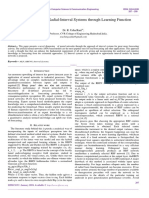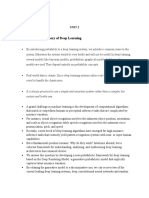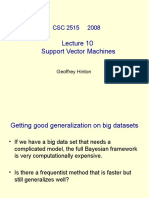Implementing A Randomized SVD Algorithm and Its Performance Analysis
Implementing A Randomized SVD Algorithm and Its Performance Analysis
Volume 6, Issue 10, October – 2021 International Journal of Innovative Science and Research Technology
ISSN No:-2456-2165
Implementing a Randomized SVD Algorithm and its
Performance Analysis
Injamamul Haque Ahmed
Abstract:- Dimension reducing techniques are becoming patterns, it can be really expensive and we might have to
more and more dominant in data science and model wait for a significant while.
predictions because it is much more efficient and
comfortable working on a small set of data than very In Modern world, we have now with the bigger and
large data. More often than not the reduced lower bigger sets of data is the higher and higher dimensional
dimensional representation seems to contain the same measurements or we can say the measuring dimensions is
properties as that of the higher dimensional space. increasing rapidly at a fast pace. But the key concept of
Additionally, big sets of data prove to be a problem in Singular Value Decomposition is that even in very large
terms of computational environment on both memory data sets there are actually a few properties or features that
and processing power and hence the need for we care about, say for our understanding and building
dimensionality reduction is key. models. So despite the increase in measuring dimensions we
can still have a low intrinsic rank available to us.
This paper discusses a dimension reducing
technique for low rank matrices called Randomized Randomized Singular Value Decomposition (RSVD)
Singular Value Decomposition (RSVD). It is a is an emerging technique in Randomized Linear Algebra
probabilistic method combined with the theory of that essentially randomly samples the column space of our
structured matrices to aid matrix factorization of any matrix, say 𝑋. So the basic idea is we randomly sample the
order. Probabilistic methods were considered to be column space of our parent matrix 𝑋 and with high
chaotic in nature at the start but the numerical results probability we are going to find a subspace that will be
are found to be quite reliable and stable. First we try and spanned by the dominating columns of 𝑈 matrix from the
show the mathematics involved in randomized singular Singular Value Decomposition.
value decompositions using concepts of Linear Algebra
and then try and formulate an algorithm based on our Note: The key motivation or the assumption while
mathematics. A random (𝟓𝟎𝟎𝟎, 𝟏𝟎𝟎𝟎) matrix is chosen working with Randomized Singular Value Decomposition is
to be factorized into a low rank 10, which is our target that there exists a low rank available that we want to
rank. uncover. We mostly call that rank as the target rank.
Generally, RSVD can be implanted using any II. ALGEBRA INVOLVED
programming language but here we use python. In
python a SVD can be implemented using a single line of The RSVD can be implemented in two main steps
code whereas the RSVD is another few lines of code. To using various Numerical Linear Algebra Techniques but all
match the theoretical performance and numerical of the algorithms generally have the same basic algebraic
performance we use RStudio to compute error construction as we discuss below.
percentage and runtime checks for both SVD and RSVD
to give us an idea of why the later proves to be a better, We want to factorize Matrix 𝑋(𝑚, 𝑛) such that 𝑋 =
fast and robust technique. The codes we developed below 𝑈𝑟 Σ𝑟 𝑉𝑟𝑇 where r is the target rank we want and 𝑈 represents
not only work for matrices but also for any grey scaled matrix of left singular vectors, Σ represents rectangular
images. diagonal matrix of singular values and 𝑉 represents a matrix
of right singular vectors.
There are various versions of the RSVD algorithm,
but we stick to the method of randomized range finder STEP 1:
method and in later parts also put in test the power 1. We take a random projection matrix 𝑃𝜖ℝ𝑛×𝑟 , where 𝑟
iteration method. is the target rank.
2. Then 𝑍 = 𝑋𝑃 𝑖. 𝑒 we shrink the column space down to 𝑟
I. INTRODUCTION and
𝑍 = 𝑄𝑅 𝑖. 𝑒 we do 𝑄𝑅 factorization in 𝑍 in place of 𝑋
We know and have already computed Singular Value itself.
Decompositions (SVD) for large data sets and although it is 3. 𝑄 gives an orthonormal basis for 𝑍 but also for 𝑋.
a fantastic tool for crunching that data down into a lower 4. Next we now project our Original data matrix 𝑋 onto
dimensional representation for extracting key features and subspace 𝑄.
IJISRT21OCT507 www.ijisrt.com 804
Volume 6, Issue 10, October – 2021 International Journal of Innovative Science and Research Technology
ISSN No:-2456-2165
STEP 2: The Algorithm
5. Now that we have orthogonal subspace for column space
of 𝑍 and 𝑋, so we project our matrix 𝑋 into the lower STEP1:
dimensional subspace 𝑄.
6. 𝑌 = 𝑄𝑇 𝑋, this is much more lower dimensional. Given an m × n matrix A and an integer 𝑙, this scheme
7. Next we compute the SVD of 𝑌 𝑖. 𝑒 𝑌 = 𝑈𝑌 Σ𝑉 𝑇 . Based computes an m× 𝑙 orthonormal matrix Q whose range
on properties of random matrix theory and structured approximates the range of A.
matrices, the Σ, 𝑉 of 𝑌 should be same as that of Σ, 𝑉 of
𝑋 discussed before, since U is the orthonormal basis that
spans the columns of 𝑋. 1. Draw an n × 𝑙 Gaussian random matrix Ω.
8. 𝑈𝑋 = 𝑄𝑈𝑌 . 2. Form the m × 𝑙 matrix Y = AΩ.
3. Construct an m× 𝑙 matrix Q whose columns form an
Generally this method of randomized singular value orthonormal basis for the range of Y, e.g., using the
decomposition outperforms the classical singular value QR factorization Y = QR.
decomposition and these claims can be supported by STEP2:
numerical experiments and followed by their detailed error
analysis. The specific benefits of randomized techniques 4. Form B = Q*A.
depend on the computational environment. Consider the
model problem of finding the k dominant components of the 5. Compute an SVD of the small matrix: B = 𝑈𝑌 ΣV*.
singular value decomposition of an m × n matrix. (i) For a 6. Set U = Q𝑼𝒀 .
dense input matrix, randomized algorithms require
O(mnlog(k)) floating-point operations (flops) in contrast to
O(mnk) for classical algorithms. (ii) For a sparse input The computation of Y in step 2 is vulnerable to round-
matrix, the flop count matches classical Krylov subspace off errors. When high accuracy is required, we sometimes
methods, but the randomized approach is more robust and incorporate an orthonormalization step between each
can easily be reorganized to exploit multiprocessor application of A and A* as we will see when we apply the
architectures. (iii) For a matrix that is too large to fit in fast power iterations.
memory, the randomized techniques require only a constant
number of passes over the data, as opposed to O(k) passes The next section is all about implementing this
for classical algorithms. algorithm into working. We use python and jupyter
notebook to compile our results. These ideas can be easily
Randomized Algorithm implemented on any programming platform such as matlab,
In recent times there has been numerous developments R, python, C++, java etc. These codes are all original work
in randomized algorithms for matrix factorization. There are and done from the scratch.
various ways in which STEP 1 discussed above can be
computed but in this paper we stick to the method of III. IMPLEMENTATION
randomized range finder and later use power scheme to see
how the it improves the runtime of the algorithms discussed The piece of code below is same as the algorithm
in Finding Structures with Randomness - Probabilistic written in the box above. It follows the same algebraic
Algorithm for Constructing Approximate Matrix pattern, though there are two factors in the code that needs a
Decomposition: N.Halko, P.G.Martinsson, J.A.Tropp. little explanation.
Problem Description 1. p(Oversampling): Often we see it is very useful to
In the fast part Suppose we have matrix 𝐴 = sample a few more columns than the prescribed target
(5000,1000) and there exist a low intrinsic rank of 10, then rank as it has been found to provide better approximate
we compute rank 𝑟( 𝑖. 𝑒 10 ) truncated single value results when used.
decomposition of 𝐴 using a fast randomized algorithm and 2. q(Power iterations):Often in dealing with matrices the
implement using some programming language. singular value doesn’t seem to decay fast enough and in
that case we multiply the matrix with some kind of a
Secondly we compare how the algorithm we have used factor that makes the singular value drop off faster. The
compare to the standard singular value decomposition in code in the third cell shows the implementation the
terms of runtime and accuracy. We also try and give an idea power scheme and the graphs below show how with
of how fast our algorithm is to normal singular value increase in the value of 𝑞 from 1 to 5, the singular values
decomposition. drop of faster. For high accuracy the factor 𝐴𝐴∗ is
multiplied on the right hand side of the equation of 𝑌 in
the second substep of step 1 in the algorithm above.
Though the use of power iterations are quite useful and
provide fast results, it is very costly and hence its
implementation since we have to move through the data
sets multiple times.
IJISRT21OCT507 www.ijisrt.com 805
Volume 6, Issue 10, October – 2021 International Journal of Innovative Science and Research Technology
ISSN No:-2456-2165
The deterministic singular value decomposition in python is a single line of code and the randomized singular value
decomposition is a few lines of codes. The above written code is very robust and work easily for matrices of arbitrary order and
can even be implemented to shapes and pictures with easy matrix reconstruction codes. In fact randomized algorithms are finding
high usage in graphics designing and image compression.
The next piece of code below is to illustrate the working and significance of power iterations as 𝑞 is run in the range 1 to 5.
The graphs and the plots below show the comparison between deterministic singular value decomposition and then randomized
ones with power iterations.
IJISRT21OCT507 www.ijisrt.com 806
Volume 6, Issue 10, October – 2021 International Journal of Innovative Science and Research Technology
ISSN No:-2456-2165
IV. GRAPHICAL RESULTS AND INTERPRETATION
The above run codes generate graphs of power iterations:
The results show that as and when go on increasing the Often we observe our singular values doesn’t decay of
value of 𝑞 = 1,2,3,4,5, the singular values decays of faster that fast but for example using the factor (𝐴𝐴∗ )𝑞 in substep
and faster and the slope of the graphs goes down and down. 2 of step 1 in our algorithm makes the singular values decay
The randomized singular value decomposition relies on the much faster. This factor 𝑞 in theory is what we call a power
fact that singular values decay vey very rapidly so that we iteration.
can approximate the dominant ones and not have them be
contaminated by lower energy ones.
IJISRT21OCT507 www.ijisrt.com 807
Volume 6, Issue 10, October – 2021 International Journal of Innovative Science and Research Technology
ISSN No:-2456-2165
Computational Time of Randomized Singular Value
Decomposition 2. package(“microbenchmark”): This package helps us
The specific benefits of the randomized techniques produce accurate timings of the said algorithm.
depend upon the computational environment we are working
with. Analysis of computational time gives us an idea of A few other packages are also used which can be easily
how the algorithm performs under various conditions and is installed using install.package().
an important topic of study in performance analysis. This
section compares the computational time or the runtime of The accuracy of the approximation can be controlled
the deterministic SVD and the randomized algorithm that we via the two tuning parameters 𝑝 and 𝑞 . The former
have discussed above for the same parent matrix. parameter is used to oversample the basis, and is set by
default to 𝑝 = 10. This setting guarantees a good basis with
We use specific tools from RStudio to make our work high probability in general. The parameter 𝑞 can be used to
easier. The reason we used R is because it provides better compute additional power iterations (subspace iterations).
and comfortable statistical computing and graphics as By default this parameter is set to 𝑞 = 2, which yields a good
compared to other programming languages. The same performance in our numerical experiments, i.e., the default
analysis though could be done via other platforms as well. values show an optimal trade-off between speed and
accuracy in standard situations.
Before we move on to the numerical calculations, we
discuss a few important R packages we used to compute the Below here is R code for compiling the runtime for our
results. algorithm for the same parent matrix describes above in the
problem description. The graph below also provides us an
1. The rsvd() function: This package helps us compute low idea of how fast in runtime is the randomized algorithm in
rank singular value decomposition as in our algorithm. contrast to the deterministic singular value decomposition.
The interface of the function is
𝑟𝑠𝑣𝑑(𝐴, 𝑘, 𝑛𝑢 = 𝑁𝑈𝐿𝐿, 𝑛𝑣 = 𝑁𝑈𝐿𝐿, 𝑝 = 10, 𝑞
= 2, 𝑠𝑑𝑖𝑠𝑡 = "𝑛𝑜𝑟𝑚𝑎𝑙)
IJISRT21OCT507 www.ijisrt.com 808
Volume 6, Issue 10, October – 2021 International Journal of Innovative Science and Research Technology
ISSN No:-2456-2165
Note: To plot this figure one must install the package experiment was carried out in a machine with Intel(R)
ggplot2 which can be easily found and implemented in Core(TM) i5-7300HQ CPU @ 2.50GHz and RAM of
RStudio. 8.00GB.
Computational Accuracy
In the following we evaluate the performance of the
randomized SVD routine of ours with the classical SVD
routine based on the error percentage. The relative
theoretical reconstruction error is computed as
∥ 𝐴 − 𝐴𝐾 ∥𝐹
∥ 𝐴 ∥𝐹
Where 𝐴𝐾 = 𝑈𝐾 Σ𝐾 𝑉𝐾𝑇 , is the rank K- matrix. To fully
exploit the power of randomized algorithm we use the
enhanced R distribution. This allows the user to control the
trade-off between computational time and accuracy,
depending on the application. Note that we have set the
precision parameter of the svd() routines to tol = 1e-5.
Below is the RStudio code to compile the error for
both the randomized technique and the deterministic SVD.
The graph shows in truth how efficient and fast the
The matrix can easily be generated as with symbols having
randomized technique is to the normal classical method.
their usual meanings,
Theoretically, a randomized technique is 4-7 times quicker
than the normal deterministic method and our numerical
R> A <- matrix(rnorm(m * r), m, r) %*% matrix(rnorm(r
experiments are in accordance with it. One must also note
* n), r, n)
that the computational times and results might vary
accordingly based on the system and environment used. This
IJISRT21OCT507 www.ijisrt.com 809
Volume 6, Issue 10, October – 2021 International Journal of Innovative Science and Research Technology
ISSN No:-2456-2165
The error in the runtime of our randomized algorithm
is found to be 4.567596𝑒 − 13, and for the deterministic
standard approach the error is 8.591737𝑒 − 13. We notice
that the error percentage is higher in classical SVD than
RSVD. We must also note that in the rsvd() package the
oversampling factor and power iteration is by default set at
𝑝 = 10, 𝑞 = 2 as discussed above. The results may vary
once we change these parameters.
V. CONCLUSIONS
This paper discusses the idea behind formulation of a
randomized algorithm for random matrices having a low
rank in it. The randomized algorithm constructed in this
paper is found to be robust and is faster in computational or
runtime in contrast to the deterministic classical SVD. The
proposed algorithm is also found to be highly accurate and
the error approximations are found to be very small and in
accordance with the theoretical studies. Overall we can say
that though the deterministic SVD makes a very good tool
for low rank matrix factorization, the randomized approach
beats this classical approach because it is much faster,
efficient and almost produces the same accurate results with
a low error term when deployed.
REFERENCES
[1]. N.Halko, P.G. Martinsson, J.A. Tropp, “Finding
structures with randomness: Probabilistic Algorithms
for Constructing Approximate Matrix Decomposition”,
SIAM Vol-53,No.2,pp-217-288.
[2]. N.B. Erichson, S. Voronin, S.L. Brunton, J.N. Kutz,
“Randomized Matrix Decomposition Using R”,
Journal of Statistical Software, Vol-89, Issue-11.
IJISRT21OCT507 www.ijisrt.com 810
You might also like
- Dijkstra's Shortest Path Algorithm Serial and Parallel Execution Performance AnalysisNo ratings yetDijkstra's Shortest Path Algorithm Serial and Parallel Execution Performance Analysis5 pages
- Coincent - Data Science With Python Assignment100% (2)Coincent - Data Science With Python Assignment23 pages
- Linear Regression Simple Technique For INo ratings yetLinear Regression Simple Technique For I3 pages
- CPD-Structured Multivariate Polynomial OptimizationNo ratings yetCPD-Structured Multivariate Polynomial Optimization24 pages
- ASTRACHAN 1991 Pictures As Invariants PDFNo ratings yetASTRACHAN 1991 Pictures As Invariants PDF7 pages
- Backpropagation: Static Backpropagation Is A Network Designed ToNo ratings yetBackpropagation: Static Backpropagation Is A Network Designed To2 pages
- A Relational Approach To The Compilation of Sparse Matrix ProgramsNo ratings yetA Relational Approach To The Compilation of Sparse Matrix Programs16 pages
- Predicting Drug Solubilty Wtih Deep LearningNo ratings yetPredicting Drug Solubilty Wtih Deep Learning9 pages
- Improved Financial Forecasting Via Quantum Machine LearningNo ratings yetImproved Financial Forecasting Via Quantum Machine Learning19 pages
- Neural Networks As Radial-Interval Systems Through Learning FunctionNo ratings yetNeural Networks As Radial-Interval Systems Through Learning Function3 pages
- Name - Sagar de UNIVERSISTY ROLL - 10931121055 Class Roll - 55 Setion A Semester - 6 Year - 3 ACADEMIC YEAR - 2023-24No ratings yetName - Sagar de UNIVERSISTY ROLL - 10931121055 Class Roll - 55 Setion A Semester - 6 Year - 3 ACADEMIC YEAR - 2023-245 pages
- A Relational Approach To The Compilation of Sparse Matrix ProgramsNo ratings yetA Relational Approach To The Compilation of Sparse Matrix Programs16 pages
- Placement Prediction Using Various Machine Learning Models and Their Efficiency ComparisonNo ratings yetPlacement Prediction Using Various Machine Learning Models and Their Efficiency Comparison5 pages
- A Probabilistic Theory of Deep Learning: Unit 2No ratings yetA Probabilistic Theory of Deep Learning: Unit 217 pages
- Tracking The Progress of The Lanczos Algorithm For Large Symmetric EigenproblemsNo ratings yetTracking The Progress of The Lanczos Algorithm For Large Symmetric Eigenproblems21 pages
- Deconstructing Randomized Algorithms With Bedpan: Mario Silva and Paulo TrufosNo ratings yetDeconstructing Randomized Algorithms With Bedpan: Mario Silva and Paulo Trufos7 pages
- A Fast K-Means Implementation Using CoresetsNo ratings yetA Fast K-Means Implementation Using Coresets10 pages
- Linear Algebra: Submitted by Ahmad Saeed Submitted To Sir Muzzam Ali BITM-F18-022No ratings yetLinear Algebra: Submitted by Ahmad Saeed Submitted To Sir Muzzam Ali BITM-F18-0225 pages
- A Parallel Maximal Independent Set Algorithm: Mark AdamsNo ratings yetA Parallel Maximal Independent Set Algorithm: Mark Adams11 pages
- You Only Linearize Once: Alexey Radul, Adam Paszke, Roy Frostig, Matthew J. Johnson, Dougal MaclaurinNo ratings yetYou Only Linearize Once: Alexey Radul, Adam Paszke, Roy Frostig, Matthew J. Johnson, Dougal Maclaurin29 pages
- Classifier Based Text Mining For Radial Basis FunctionNo ratings yetClassifier Based Text Mining For Radial Basis Function6 pages
- On Symbolic Approaches For Computing The Matrix PermanentNo ratings yetOn Symbolic Approaches For Computing The Matrix Permanent18 pages
- On Application of Omp and Cosamp Algorithms For Doa Estimation ProblemNo ratings yetOn Application of Omp and Cosamp Algorithms For Doa Estimation Problem5 pages
- Robust Algorithms For Online Convex Problems Via Primal-DualNo ratings yetRobust Algorithms For Online Convex Problems Via Primal-Dual22 pages
- Ordered Weighted Averaging Aggregation Operator: Fundamentals and ApplicationsFrom EverandOrdered Weighted Averaging Aggregation Operator: Fundamentals and ApplicationsNo ratings yet
- Epistemic Risks of Big Data Analytics in Scientific Discovery: Analysis of the Reliability and Biases of Inductive Reasoning in Large-Scale DatasetsNo ratings yetEpistemic Risks of Big Data Analytics in Scientific Discovery: Analysis of the Reliability and Biases of Inductive Reasoning in Large-Scale Datasets7 pages
- The Digital Influence ChatGPT and its Role in Shaping Youth Cognitive Processes and Decision-MakingNo ratings yetThe Digital Influence ChatGPT and its Role in Shaping Youth Cognitive Processes and Decision-Making5 pages
- To Compare the Effectiveness of Jacobson’s Relaxation Techniques and Mitchell’s Relaxation Techniques along with Diaphragmatic Breathing on Insomnia in Elderly IndividualsNo ratings yetTo Compare the Effectiveness of Jacobson’s Relaxation Techniques and Mitchell’s Relaxation Techniques along with Diaphragmatic Breathing on Insomnia in Elderly Individuals9 pages
- Influence of Age, Gender, Socioeconomic Status, and Education Level on Glycemic Control in Diabetic Patients Attending Kapkatet Sub-County Hospital, Kericho County, KenyaNo ratings yetInfluence of Age, Gender, Socioeconomic Status, and Education Level on Glycemic Control in Diabetic Patients Attending Kapkatet Sub-County Hospital, Kericho County, Kenya9 pages
- Bridging the Digital Divide in Agriculture: Lessons from the United States and Africa in Smart Farming AdoptionNo ratings yetBridging the Digital Divide in Agriculture: Lessons from the United States and Africa in Smart Farming Adoption10 pages
- A Comparative Analysis of Natural Language Processing Models: BERT and LSTM in Enhancing Business CommunicationNo ratings yetA Comparative Analysis of Natural Language Processing Models: BERT and LSTM in Enhancing Business Communication6 pages
- From Visualization to Purchase: How Augmented Reality (AR), Virtual Reality (VR) and Artificial Intelligence (AI) Influence Consumer Purchase Decisions in Housing Design DecisionsNo ratings yetFrom Visualization to Purchase: How Augmented Reality (AR), Virtual Reality (VR) and Artificial Intelligence (AI) Influence Consumer Purchase Decisions in Housing Design Decisions23 pages
- Case Study and Examination of Production Methods in a Steel Manufacturing FacilityNo ratings yetCase Study and Examination of Production Methods in a Steel Manufacturing Facility7 pages
- Impact of Storytelling and Emotional Branding on Consumer Purchase Behavior in Quick Service Restaurants and FMCGNo ratings yetImpact of Storytelling and Emotional Branding on Consumer Purchase Behavior in Quick Service Restaurants and FMCG15 pages
- Comparing the Effect of Ashoka Ointment and Herjet OintmentNo ratings yetComparing the Effect of Ashoka Ointment and Herjet Ointment5 pages
- AI-Driven Predictive Analytics for Syndromic Surveillance: Enhancing Early Detection of Emerging Infectious Diseases in the United StatesNo ratings yetAI-Driven Predictive Analytics for Syndromic Surveillance: Enhancing Early Detection of Emerging Infectious Diseases in the United States8 pages
- Geriatric Medication Management Using STOPP/START Criteria on Polypharmacy in a Multicentre Hospital: A Systematic ReviewNo ratings yetGeriatric Medication Management Using STOPP/START Criteria on Polypharmacy in a Multicentre Hospital: A Systematic Review6 pages
- Remarkable Spatial Influences behind Shaping the Bangla Dance: Performer and Audience PerspectivesNo ratings yetRemarkable Spatial Influences behind Shaping the Bangla Dance: Performer and Audience Perspectives8 pages
- Psychological Well-being among Tribal and Non-Tribal B.Ed. StudentsNo ratings yetPsychological Well-being among Tribal and Non-Tribal B.Ed. Students4 pages
- Affirmative Policy on Belis in Marriage Traditions at Family Institutions in the Abenaho District of PapuaNo ratings yetAffirmative Policy on Belis in Marriage Traditions at Family Institutions in the Abenaho District of Papua14 pages
- Synergizing Renewables with Power Grid: A Path towards Stability and SustainabilityNo ratings yetSynergizing Renewables with Power Grid: A Path towards Stability and Sustainability5 pages
- Library Personnel’s Career Development and Job Performance of the National UniversityNo ratings yetLibrary Personnel’s Career Development and Job Performance of the National University8 pages
- Autonomous Obstacle Avoiding and Pesticide Spraying Robot for Smart FarmingNo ratings yetAutonomous Obstacle Avoiding and Pesticide Spraying Robot for Smart Farming4 pages
- Factors Influencing the Organizational Performance of Hotel EstablishmentsNo ratings yetFactors Influencing the Organizational Performance of Hotel Establishments12 pages
- An Integrated Web Application for Campus Life: A Digital Solution for Learning and VotingNo ratings yetAn Integrated Web Application for Campus Life: A Digital Solution for Learning and Voting8 pages
- Structural Equation Modeling of Students’ Performance in Pre-Calculus: Basis for Intervention in Senior High School100% (1)Structural Equation Modeling of Students’ Performance in Pre-Calculus: Basis for Intervention in Senior High School12 pages
- Citizen Satisfaction with Electronic-Government Services: A Case Study of Huduma Centre MombasaNo ratings yetCitizen Satisfaction with Electronic-Government Services: A Case Study of Huduma Centre Mombasa13 pages
- Leveraging Digital Surveillance Technologies for Managing Border Porosity and Enhancing Revenue Collection in KenyaNo ratings yetLeveraging Digital Surveillance Technologies for Managing Border Porosity and Enhancing Revenue Collection in Kenya11 pages
- Leveraging Wi-Fi-Based Tracking for Enhanced Conference Management and Exhibitor ValueNo ratings yetLeveraging Wi-Fi-Based Tracking for Enhanced Conference Management and Exhibitor Value11 pages
- Precision, Prediction and Progress: A New Era in PharmacologyNo ratings yetPrecision, Prediction and Progress: A New Era in Pharmacology23 pages
- Imran Baig_DST_Springer_s11276-013-0671-0_2014No ratings yetImran Baig_DST_Springer_s11276-013-0671-0_201410 pages
- Sure Cross Multihop Data Radio: DatasheetNo ratings yetSure Cross Multihop Data Radio: Datasheet7 pages
- How Our Unhealthy Cybersecurity Infrastructure Is Hurting BiotechnologyNo ratings yetHow Our Unhealthy Cybersecurity Infrastructure Is Hurting Biotechnology4 pages
- Top 5 Sites To Buy Verified PayPal Accounts (Personal andNo ratings yetTop 5 Sites To Buy Verified PayPal Accounts (Personal and7 pages
- CUMT105 Tutorial Worksheet 3 Basic Probability ConceptsNo ratings yetCUMT105 Tutorial Worksheet 3 Basic Probability Concepts3 pages
- EDR EVASION Unhook Syscalls Indirect Syacalls 1682700077No ratings yetEDR EVASION Unhook Syscalls Indirect Syacalls 168270007732 pages
- Unit 3: Snmpv1 Network Management - Organization & Information ModelsNo ratings yetUnit 3: Snmpv1 Network Management - Organization & Information Models3 pages
- Ibps RRB Po Memory Based Questions Discussion 5th Aug 2023 English 611685760538582No ratings yetIbps RRB Po Memory Based Questions Discussion 5th Aug 2023 English 61168576053858233 pages
- Evolution - Downloads_ Instruction manualsNo ratings yetEvolution - Downloads_ Instruction manuals4 pages
- Multiples of A Given Number Up To 100: Study The Table Below. Answer What Is AskedNo ratings yetMultiples of A Given Number Up To 100: Study The Table Below. Answer What Is Asked14 pages
- The Beginners Guide To Gerber File Extensions100% (1)The Beginners Guide To Gerber File Extensions13 pages
- Dijkstra's Shortest Path Algorithm Serial and Parallel Execution Performance AnalysisDijkstra's Shortest Path Algorithm Serial and Parallel Execution Performance Analysis
- CPD-Structured Multivariate Polynomial OptimizationCPD-Structured Multivariate Polynomial Optimization
- Backpropagation: Static Backpropagation Is A Network Designed ToBackpropagation: Static Backpropagation Is A Network Designed To
- A Relational Approach To The Compilation of Sparse Matrix ProgramsA Relational Approach To The Compilation of Sparse Matrix Programs
- Improved Financial Forecasting Via Quantum Machine LearningImproved Financial Forecasting Via Quantum Machine Learning
- Neural Networks As Radial-Interval Systems Through Learning FunctionNeural Networks As Radial-Interval Systems Through Learning Function
- Name - Sagar de UNIVERSISTY ROLL - 10931121055 Class Roll - 55 Setion A Semester - 6 Year - 3 ACADEMIC YEAR - 2023-24Name - Sagar de UNIVERSISTY ROLL - 10931121055 Class Roll - 55 Setion A Semester - 6 Year - 3 ACADEMIC YEAR - 2023-24
- A Relational Approach To The Compilation of Sparse Matrix ProgramsA Relational Approach To The Compilation of Sparse Matrix Programs
- Placement Prediction Using Various Machine Learning Models and Their Efficiency ComparisonPlacement Prediction Using Various Machine Learning Models and Their Efficiency Comparison
- Tracking The Progress of The Lanczos Algorithm For Large Symmetric EigenproblemsTracking The Progress of The Lanczos Algorithm For Large Symmetric Eigenproblems
- Deconstructing Randomized Algorithms With Bedpan: Mario Silva and Paulo TrufosDeconstructing Randomized Algorithms With Bedpan: Mario Silva and Paulo Trufos
- Linear Algebra: Submitted by Ahmad Saeed Submitted To Sir Muzzam Ali BITM-F18-022Linear Algebra: Submitted by Ahmad Saeed Submitted To Sir Muzzam Ali BITM-F18-022
- A Parallel Maximal Independent Set Algorithm: Mark AdamsA Parallel Maximal Independent Set Algorithm: Mark Adams
- You Only Linearize Once: Alexey Radul, Adam Paszke, Roy Frostig, Matthew J. Johnson, Dougal MaclaurinYou Only Linearize Once: Alexey Radul, Adam Paszke, Roy Frostig, Matthew J. Johnson, Dougal Maclaurin
- Classifier Based Text Mining For Radial Basis FunctionClassifier Based Text Mining For Radial Basis Function
- On Symbolic Approaches For Computing The Matrix PermanentOn Symbolic Approaches For Computing The Matrix Permanent
- On Application of Omp and Cosamp Algorithms For Doa Estimation ProblemOn Application of Omp and Cosamp Algorithms For Doa Estimation Problem
- Robust Algorithms For Online Convex Problems Via Primal-DualRobust Algorithms For Online Convex Problems Via Primal-Dual
- Ordered Weighted Averaging Aggregation Operator: Fundamentals and ApplicationsFrom EverandOrdered Weighted Averaging Aggregation Operator: Fundamentals and Applications
- Epistemic Risks of Big Data Analytics in Scientific Discovery: Analysis of the Reliability and Biases of Inductive Reasoning in Large-Scale DatasetsEpistemic Risks of Big Data Analytics in Scientific Discovery: Analysis of the Reliability and Biases of Inductive Reasoning in Large-Scale Datasets
- The Digital Influence ChatGPT and its Role in Shaping Youth Cognitive Processes and Decision-MakingThe Digital Influence ChatGPT and its Role in Shaping Youth Cognitive Processes and Decision-Making
- To Compare the Effectiveness of Jacobson’s Relaxation Techniques and Mitchell’s Relaxation Techniques along with Diaphragmatic Breathing on Insomnia in Elderly IndividualsTo Compare the Effectiveness of Jacobson’s Relaxation Techniques and Mitchell’s Relaxation Techniques along with Diaphragmatic Breathing on Insomnia in Elderly Individuals
- Influence of Age, Gender, Socioeconomic Status, and Education Level on Glycemic Control in Diabetic Patients Attending Kapkatet Sub-County Hospital, Kericho County, KenyaInfluence of Age, Gender, Socioeconomic Status, and Education Level on Glycemic Control in Diabetic Patients Attending Kapkatet Sub-County Hospital, Kericho County, Kenya
- Bridging the Digital Divide in Agriculture: Lessons from the United States and Africa in Smart Farming AdoptionBridging the Digital Divide in Agriculture: Lessons from the United States and Africa in Smart Farming Adoption
- A Comparative Analysis of Natural Language Processing Models: BERT and LSTM in Enhancing Business CommunicationA Comparative Analysis of Natural Language Processing Models: BERT and LSTM in Enhancing Business Communication
- From Visualization to Purchase: How Augmented Reality (AR), Virtual Reality (VR) and Artificial Intelligence (AI) Influence Consumer Purchase Decisions in Housing Design DecisionsFrom Visualization to Purchase: How Augmented Reality (AR), Virtual Reality (VR) and Artificial Intelligence (AI) Influence Consumer Purchase Decisions in Housing Design Decisions
- Case Study and Examination of Production Methods in a Steel Manufacturing FacilityCase Study and Examination of Production Methods in a Steel Manufacturing Facility
- Impact of Storytelling and Emotional Branding on Consumer Purchase Behavior in Quick Service Restaurants and FMCGImpact of Storytelling and Emotional Branding on Consumer Purchase Behavior in Quick Service Restaurants and FMCG
- Comparing the Effect of Ashoka Ointment and Herjet OintmentComparing the Effect of Ashoka Ointment and Herjet Ointment
- AI-Driven Predictive Analytics for Syndromic Surveillance: Enhancing Early Detection of Emerging Infectious Diseases in the United StatesAI-Driven Predictive Analytics for Syndromic Surveillance: Enhancing Early Detection of Emerging Infectious Diseases in the United States
- Geriatric Medication Management Using STOPP/START Criteria on Polypharmacy in a Multicentre Hospital: A Systematic ReviewGeriatric Medication Management Using STOPP/START Criteria on Polypharmacy in a Multicentre Hospital: A Systematic Review
- Remarkable Spatial Influences behind Shaping the Bangla Dance: Performer and Audience PerspectivesRemarkable Spatial Influences behind Shaping the Bangla Dance: Performer and Audience Perspectives
- Psychological Well-being among Tribal and Non-Tribal B.Ed. StudentsPsychological Well-being among Tribal and Non-Tribal B.Ed. Students
- Affirmative Policy on Belis in Marriage Traditions at Family Institutions in the Abenaho District of PapuaAffirmative Policy on Belis in Marriage Traditions at Family Institutions in the Abenaho District of Papua
- Synergizing Renewables with Power Grid: A Path towards Stability and SustainabilitySynergizing Renewables with Power Grid: A Path towards Stability and Sustainability
- Library Personnel’s Career Development and Job Performance of the National UniversityLibrary Personnel’s Career Development and Job Performance of the National University
- Autonomous Obstacle Avoiding and Pesticide Spraying Robot for Smart FarmingAutonomous Obstacle Avoiding and Pesticide Spraying Robot for Smart Farming
- Factors Influencing the Organizational Performance of Hotel EstablishmentsFactors Influencing the Organizational Performance of Hotel Establishments
- An Integrated Web Application for Campus Life: A Digital Solution for Learning and VotingAn Integrated Web Application for Campus Life: A Digital Solution for Learning and Voting
- Structural Equation Modeling of Students’ Performance in Pre-Calculus: Basis for Intervention in Senior High SchoolStructural Equation Modeling of Students’ Performance in Pre-Calculus: Basis for Intervention in Senior High School
- Citizen Satisfaction with Electronic-Government Services: A Case Study of Huduma Centre MombasaCitizen Satisfaction with Electronic-Government Services: A Case Study of Huduma Centre Mombasa
- Leveraging Digital Surveillance Technologies for Managing Border Porosity and Enhancing Revenue Collection in KenyaLeveraging Digital Surveillance Technologies for Managing Border Porosity and Enhancing Revenue Collection in Kenya
- Leveraging Wi-Fi-Based Tracking for Enhanced Conference Management and Exhibitor ValueLeveraging Wi-Fi-Based Tracking for Enhanced Conference Management and Exhibitor Value
- Precision, Prediction and Progress: A New Era in PharmacologyPrecision, Prediction and Progress: A New Era in Pharmacology
- How Our Unhealthy Cybersecurity Infrastructure Is Hurting BiotechnologyHow Our Unhealthy Cybersecurity Infrastructure Is Hurting Biotechnology
- Top 5 Sites To Buy Verified PayPal Accounts (Personal andTop 5 Sites To Buy Verified PayPal Accounts (Personal and
- CUMT105 Tutorial Worksheet 3 Basic Probability ConceptsCUMT105 Tutorial Worksheet 3 Basic Probability Concepts
- EDR EVASION Unhook Syscalls Indirect Syacalls 1682700077EDR EVASION Unhook Syscalls Indirect Syacalls 1682700077
- Unit 3: Snmpv1 Network Management - Organization & Information ModelsUnit 3: Snmpv1 Network Management - Organization & Information Models
- Ibps RRB Po Memory Based Questions Discussion 5th Aug 2023 English 611685760538582Ibps RRB Po Memory Based Questions Discussion 5th Aug 2023 English 611685760538582
- Multiples of A Given Number Up To 100: Study The Table Below. Answer What Is AskedMultiples of A Given Number Up To 100: Study The Table Below. Answer What Is Asked























































































































